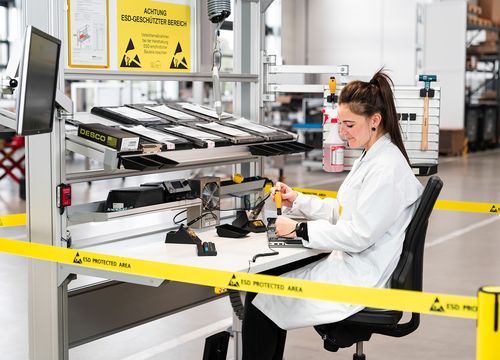New white paper from item
Electrostatic discharges (ESDs) that occur in production or further processing stages cause weaknesses in electronic components. If they are not identified, not only do they threaten product quality but, in the long term, they can also put a company’s success at risk. In a new white paper, item Industrietechnik GmbH offers an overview of the various risk factors and consequences of ESDs. The specialist in work bench systems and building kit systems for industrial applications also provides details on how to consistently implement an ESD safety concept – and ensure hazardous charges don’t build up in the first place.
The risks of electrostatic charge accumulation are just as diverse as the causes of ESD damage. Contributing factors include synthetic clothing, unsuitable tools, textile floor coverings and conventional office chairs. Without precautionary measures, discharges can occur at any time – from as early as the goods receipt of at-risk electronic components right through the production chain to the moment when the finished product is delivered to the customer. The problem in industry is that these discharges either go unnoticed or their effects are simply underestimated due to inadequate knowledge of the issues involved. The components often don’t show any signs of malfunction during quality assurance processes, but a subsequent examination under an electron microscope will reveal visible fusing and craters on the surface. By then, it is usually too late. The faulty components will already have been used for subsequent steps in the value chain or been delivered straight to the customer. This is when the components fail. In the medium term, damaged electronic components emanating from your own production ultimately undermine customers’ trust in your business and, in the worst-case scenario, can lead to product liability claims or the loss of supplier status.
How can a company implement an ESD safety concept?
To ensure problems never get that bad, ESD safety requirements need to be met in full and at all times in critical production areas. In its white paper “The basics of ESD safety”, item sets out how a concept like this can be established throughout an entire company. The document includes a guide to dealing with ESD-sensitive components, practical tips on avoiding ESD damage and information on how staff should conduct themselves in an ‘electrostatic protected area’ (EPA). It also outlines the essentials for an EPA, describes the materials that can be used in the handling area and presents all the necessary information about standard-compliant protective clothing, control programmes and staff training. One thing is certain – the best way to prevent weaknesses caused by ESDs and the resultant serious, long-lasting consequences for your company’s success is to put in place a comprehensive safety concept, pursue it consistently and bring on board cooperation partners and service providers.
The white paper is available to download for free https://welcome.item24.com/esd-basics-whitepaper.
Length: 3,044 characters (including spaces)
Date: 15 April 2020
Photos: 3
Caption 1: Only trained staff and visitors who have been given suitable instruction with the appropriate protective equipment may enter an electrostatic protected area, or EPA. Source: item
Caption 2: During retrospective examinations conducted using electron microscopes, components damaged by an ESD reveal visible fusing and craters on the silicon surface. Source: item
Caption 3: As employees both carry and transfer charges, they must wear an ESD wristband to prevent the accumulation of electrostatic charges when handling ESD-sensitive components. Source: item
